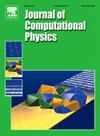考虑不同相可压缩性的多相流一致δ+-SPH模型的扩展
IF 3.8
2区 物理与天体物理
Q2 COMPUTER SCIENCE, INTERDISCIPLINARY APPLICATIONS
引用次数: 0
摘要
在涉及波浪冲击结构的水动力问题中,空气可压缩性是气泡被困时准确预测压力的关键。在这项工作中,最初为单相场景开发的一致δ+-SPH模型被扩展到多相环境。尽管一致δ+-SPH模型在单相和粘性流动模拟中表现出良好的性能,但将其扩展到多相场景中存在挑战,例如多相界面中如何正确实现颗粒移动。因此,在一致δ+-SPH的框架下,我们引入了以下改进:首先,提出了处理多相界面上粒子移动技术给出的δu项的新策略,以保持稳定性和守恒性。其次,在水等不可压缩相的建模中,引入声阻尼项来缓解弱可压缩假设产生的声波,期望获得与真不可压缩假设相当的平滑压力场,从而减少剧烈冲击状态下的非物理压力波;在模拟空气等可压缩相时,在状态方程中采用物理声速来准确地模拟真实气相的可压缩性。为了测试和验证多相SPH模型,对6种情况进行了模拟。特别是,除了两层液体的晃动外,其他场景充分考虑了空气被周围流动捕获、压缩或膨胀时的气压振荡。结果表明,该SPH模型在模拟强液体冲击和不同相压缩率的多相问题方面具有显著优势。本文章由计算机程序翻译,如有差异,请以英文原文为准。

Extension of the consistent δ+-SPH model for multiphase flows considering the compressibility of different phases
In hydrodynamic problems involving wave impact on structures, air compressibility is crucial for accurate pressure prediction when air bubbles are entrapped. In this work, the consistent -SPH model, originally developed for single-phase scenarios, is extended to multiphase contexts. Although the consistent -SPH model shows good performance for single phase and viscous flow simulations, extending it to multiphase scenarios presents challenges, such as proper implementation of particle shifting for multiphase interfaces. Therefore, within the framework of the consistent -SPH, we introduce the following enhancements: firstly, new strategies for handling -terms given by the particle shifting technique at multiphase interfaces are proposed to maintain stability and conservation. Secondly, for modeling of incompressible phases, like water, an acoustic damper term is introduced to alleviate acoustic waves resulting from the weakly-compressible assumption, which is expected to achieve smooth pressure field comparable to truly-incompressible hypothesis, thereby reducing the nonphysical pressure wave during the violent impact state; for modeling compressible phases like air, a physical sound speed is adopted in the equation of state to accurately model real gas phase compressibility. To test and validate the present multiphase SPH model, simulations were conducted for six scenarios. In particular, except for sloshing with two-layer liquids, the other scenarios fully consider air pressure oscillations when air is entrapped, compressed, or expanded by surrounding flows. The results demonstrate significant advantages of the present SPH model in simulating multiphase problems involving strong liquid impact and different phase compressibility.
求助全文
通过发布文献求助,成功后即可免费获取论文全文。
去求助
来源期刊

Journal of Computational Physics
物理-计算机:跨学科应用
CiteScore
7.60
自引率
14.60%
发文量
763
审稿时长
5.8 months
期刊介绍:
Journal of Computational Physics thoroughly treats the computational aspects of physical problems, presenting techniques for the numerical solution of mathematical equations arising in all areas of physics. The journal seeks to emphasize methods that cross disciplinary boundaries.
The Journal of Computational Physics also publishes short notes of 4 pages or less (including figures, tables, and references but excluding title pages). Letters to the Editor commenting on articles already published in this Journal will also be considered. Neither notes nor letters should have an abstract.
 求助内容:
求助内容: 应助结果提醒方式:
应助结果提醒方式:


